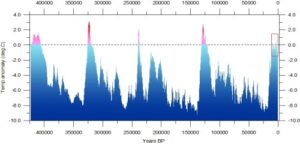by Javier, Oct 24, 2016 in ClimateEtc.
Insights into the debate on whether the Holocene will be long or short.
Summary: Milankovitch Theory on the effects of Earth’s orbital variations on insolation remains the most popular explanation for the glacial cycle since the early 1970’s. According to its defenders, the main determinant of a glacial period termination is high 65° N summer insolation, and a 100 kyr cycle in eccentricity induces a non-linear response that determines the pacing of interglacials. Based on this theory some authors propose that the current interglacial is going to be a very long one due to a favorable evolution of 65° N summer insolation. Available evidence, however, supports that the pacing of interglacials is determined by obliquity, that the 100 kyr spacing of interglacials is not real, and that the orbital configuration and thermal evolution of the Holocene does not significantly depart from the average interglacial of the past 800,000 years, so there is no orbital support for a long Holocene.
…
…
by M.O. Jonas, 2022, WorldJ.Adv.ResReviews
World Journal of Advanced Research and Reviews, 2022, 13(03), 388–392
Article DOI: 10.30574/wjarr.2022.13.3.0259
Publication history:
Received on 18 February 2022; revised on 20 March 2022; accepted on 22 March 2022
Abstract:
The “100,000-year problem” refers to an apparent unexplained change in the frequency of inter-glacial periods which occurred about a million years ago. Before that, inter-glacial periods seemed to occur about every 41,000 years, in line with the obliquity Milankovich cycle. But after that, they seemed to occur about every 100,000 years, in line with the orbital inclination Milankovich cycle. Examination of the data shows that there never was a 41,000-year cycle, and that there is no 100,000-year cycle, but that the most influential cycle is the approx 21,000-year precession cycle which is the major factor in the cycles of insolation at higher latitudes. Insolation at 65N is generally regarded as the most significant of these. Inspection of the data shows that every glacial termination (start of an inter-glacial period) began at a time when insolation at 65N increased from a low point in its cycle. That not every such cycle triggered a new inter-glacial period underlines the chaotic non-linear nature of Earth’s climate. Until about a million years ago, this cycle occasionally “missed a beat”, making the inter-glacial frequency average about 41,000 years. After that, the cycle started missing more “beats”, making the inter-glacial frequency average about 100,000 years. There never was an actual 41,000-year or 100,000-year inter-glacial cycle.
Keywords:
Climate; Glacial Termination; Inter-Glacial; Milankovich Cycle; Non-Linear; Precession
Full text article in PDF:
by W. Jones, January 22, 2020 in ClimateChangeDispatch
Did you know that over the last 450,000 years there have been four Ice Ages lasting around 100,000 years each?
And five interglacial periods lasting around 12,000 years each?
Look at this graph of temperature data derived from the Vostok ice core from Antarctica.

What it means is that for around 90 percent of the last 450,000 years Earth has been in an Ice Age, where global temperatures have slumped to as low as 10 deg C colder than in the relatively brief interglacial periods.
The current interglacial period (the fifth) began about 11,600 years ago, suggesting it may not last much longer. It corresponds to the time when human beings began farming and building cities and civilizations.
It is notably cooler than the previous four interglacial periods. If we ‘zoom in’ on it (see the upper graph, below)
…
La géologie, une science plus que passionnante … et diverse

